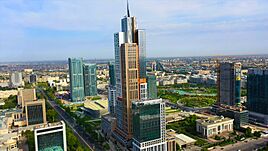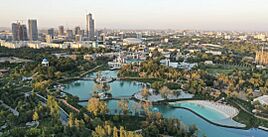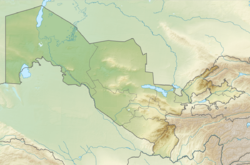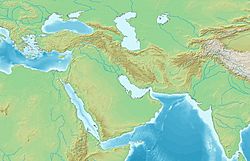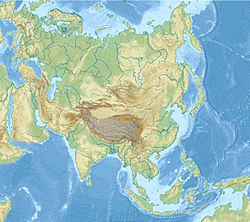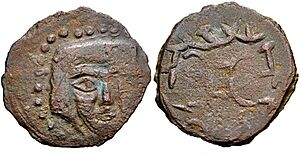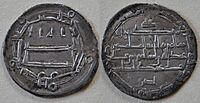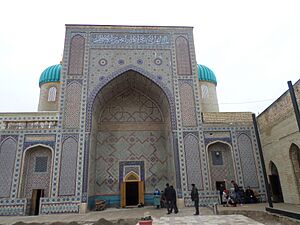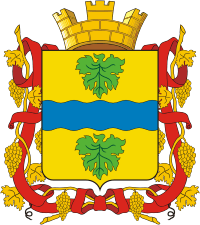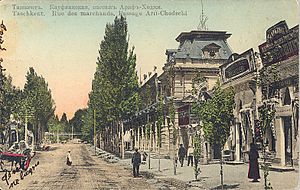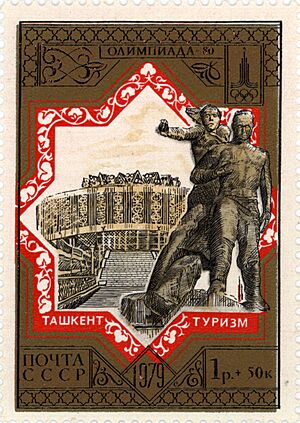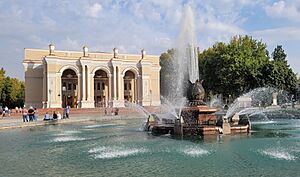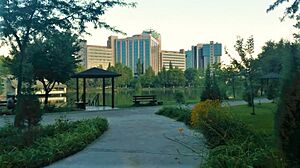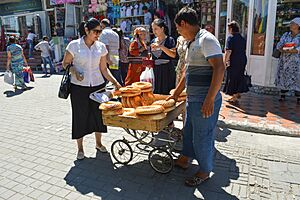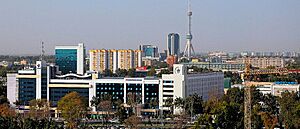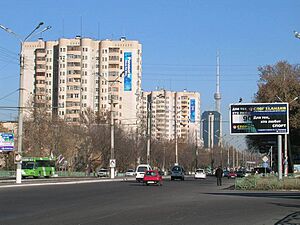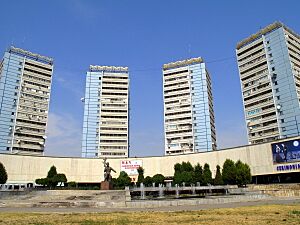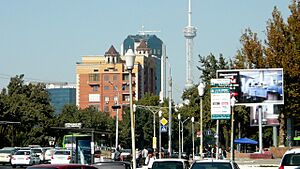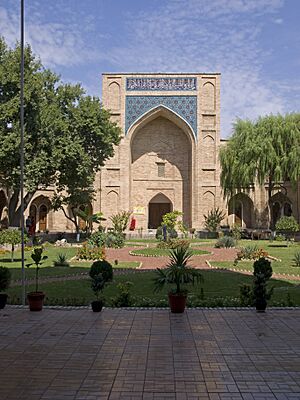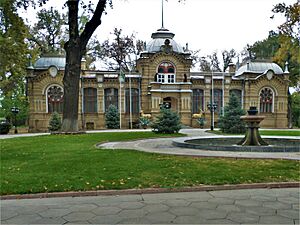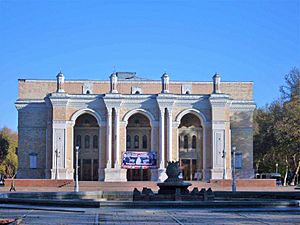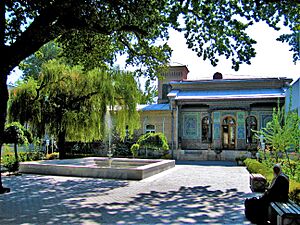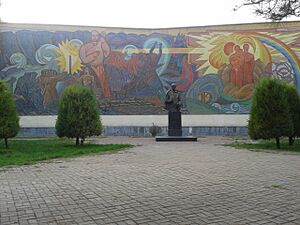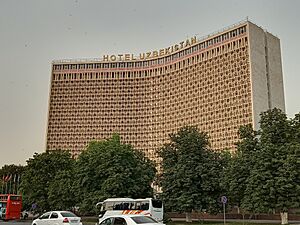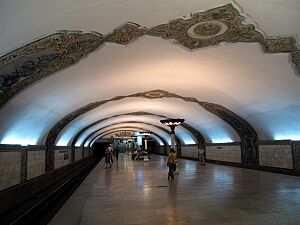Tashkent facts for kids
Quick facts for kids
Tashkent
Toshkent
Ташкент, Tachkent, Tashkand, Toshkent
|
|||||||||||||||
|---|---|---|---|---|---|---|---|---|---|---|---|---|---|---|---|
| Tashkent | |||||||||||||||
|
Clockwise from top: Skyline of Tashkent, Kukeldash Madrasa, Cathedral of the Dormition of the Mother of God, Supreme Assembly building, Amir Timur Museum, Humo Ice Dome, Hilton Tashkent City, Tashkent at night.
|
|||||||||||||||
|
|||||||||||||||
| Nickname(s):
Tosh (A rock)
|
|||||||||||||||
| Motto(s):
Kuch Adolatdadir
("Strength is in Justice") |
|||||||||||||||
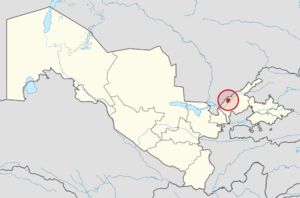 |
|||||||||||||||
| Country | |||||||||||||||
| Settled | 3rd century BCE | ||||||||||||||
| Divisions | 12 districts | ||||||||||||||
| Government | |||||||||||||||
| • Type | City Administration | ||||||||||||||
| Area | |||||||||||||||
| • Capital city | 631.29 km2 (243.74 sq mi) | ||||||||||||||
| • Metro | 6,400 km2 (2,500 sq mi) | ||||||||||||||
| Dimensions | |||||||||||||||
| • Length | 25 km (16 mi) | ||||||||||||||
| • Width | 30 km (20 mi) | ||||||||||||||
| Elevation | 455 m (1,493 ft) | ||||||||||||||
| Population
(1 January 2024)
|
|||||||||||||||
| • Capital city | +3,040,800 | ||||||||||||||
| • Rank | 1st in Uzbekistan | ||||||||||||||
| • Density | 4,816/km2 (12,470/sq mi) | ||||||||||||||
| • Urban | 2,575,431 | ||||||||||||||
| • Metro | 2,633,661 | ||||||||||||||
| • Metro density | 412/km2 (1,066/sq mi) | ||||||||||||||
| Time zone | UTC+05:00 (Uzbekistan Time) | ||||||||||||||
| • Summer (DST) | (Not Observed) | ||||||||||||||
| Area code(s) | 71 | ||||||||||||||
| Vehicle registration | 01 | ||||||||||||||
| HDI (2019) | 0.820 very high |
||||||||||||||
| International Airports | Islam Karimov Tashkent International Airport | ||||||||||||||
| Rapid transit system | Tashkent Metro | ||||||||||||||
|
|||||||||||||||
Tashkent (also spelled Toshkent in Uzbek) is the capital and largest city of Uzbekistan. It is the biggest city in Central Asia, with over 3 million people living there as of April 2024. Tashkent is located in northeastern Uzbekistan, close to the border with Kazakhstan.
Long ago, before Islam arrived in the mid-8th century, the city was influenced by Sogdian and Turkic cultures. In 1219, Genghis Khan destroyed the city. But it was rebuilt and became important because it was on the Silk Road, a famous trade route.
From the 1700s to the 1800s, Tashkent was an independent city. Then, it was taken over by the Khanate of Kokand. In 1865, the Russian Empire took control, and Tashkent became the capital of Russian Turkestan. During the time of the Soviet Union, the city grew a lot. Many people moved there, sometimes because they were forced to.
In 1966, a big earthquake destroyed much of Tashkent. However, it was quickly rebuilt as a modern Soviet city. At that time, it was the fourth-largest city in the Soviet Union.
Today, Tashkent is the capital of independent Uzbekistan. It has many different ethnic groups, but most people are Uzbeks. In 2009, the city celebrated 2,200 years of its written history.
Contents
History of Tashkent
What's in a Name?
Tashkent has had many names over its long history. The name "Tashkent" comes from the Turkic word tash (stone) and the Persian word kent (city). So, it means "Stone City" or "City of Stones."
Long ago, the city was known as Chach. The famous Persian poet Ferdowsi also called it Chach in his book, the Shahnameh. Over time, the name changed from Chachkand to Tashkand, and then to the modern "Tashkent."
Early Beginnings
Tashkent was first settled between 500 and 300 BC. It was an oasis (a fertile spot in a desert) located on the Chirchik River, near the Tian Shan Mountains.
Some historians believe that a "Stone Tower" mentioned by the ancient writer Ptolemy was located here. This tower was said to be the halfway point between Europe and China on the old Silk Road.
Chach: An Ancient Trading Hub
Before Islam, the city and its area were called Chach. Around 500 to 300 BC, a square fortress was built about 8 kilometers south of the Syr Darya River.
By the 600s AD, Chach had over 30 towns and more than 50 canals. This made it an important trade center between the Sogdians and Turkic nomads. The Buddhist monk Xuanzang, who traveled from China to India, also mentioned the city.
Under Islamic Rule
In the early 700s, Chach was taken over by the Umayyad Caliphate, an Islamic empire. The city was divided into different parts: a fortress, an inner city, and two suburbs. The fortress held the ruler's palace and a prison.
Later, under the Samanid Empire, the city was known as Binkath. However, the Arabs still called the surrounding region ash-Shāsh. A famous Islamic scholar named Abu Bakr Muhammad ibn Ali ash-Shashi was born in Tashkent in the 900s.
Mongol Invasion and Revival
In 1219, Genghis Khan and his Mongols attacked and destroyed Tashkent. Many people were lost, and the city suffered greatly.
However, under later dynasties like the Timurids and Shaybanids, Tashkent slowly came back to life. It became an important center for learning, business, and trade along the Silk Road once more.
During the time of Timur (1336-1405), Tashkent was rebuilt and became a key city in his empire. Timur even started a military campaign from Tashkent in 1391.
Uzbek and Kazakh Rule
In the 1500s, the Shaybanid dynasty ruled Tashkent. One ruler, Suyunchkhoja Khan, was known for supporting scientists, writers, and poets.
Later, from 1598 to 1723, Tashkent was part of the Kazakh Khanate.
Independent Tashkent and Kokand Control
In 1784, a local ruler named Yunus Khoja united the city and created an independent Tashkent state. This state grew to control large areas by the early 1800s.
But in 1809, Tashkent was taken over by the Khanate of Kokand. At this time, Tashkent was a very rich city with about 100,000 people. It traded a lot with Russia, but people were unhappy with the high taxes from Kokand.
Russian Empire Takes Over

In May 1865, a Russian general named Mikhail Grigorevich Chernyayev attacked Tashkent. Even though his army was much smaller, they captured the city after two days of fighting. Chernyayev became known as the "Lion of Tashkent."
He tried to win over the people by removing taxes for a year and meeting with them. He wanted Tashkent to be an independent state under Russian protection. However, the Russian Tsar had other plans.
Instead of independence, Tashkent became the capital of a new Russian territory called Russian Turkistan. Many Russian settlers and traders moved to the city. The Trans-Caspian Railway arrived in 1889, bringing more people and new ideas, including those that led to the Bolshevik Revolution.
The Soviet Era
After the fall of the Russian Empire, Tashkent became the capital of the Turkestan Autonomous Soviet Socialist Republic in 1918. The city started to grow as an industrial center in the 1920s and 1930s.
During World War II, many factories and people were moved to Tashkent from western Russia and Ukraine to keep Soviet industry going. This caused the city's population to grow to over a million people. Many of these refugees stayed in Tashkent after the war.
On January 10, 1966, the leaders of India and Pakistan signed a peace agreement in Tashkent. The next day, the Indian Prime Minister, Lal Bahadur Shastri, sadly passed away.
On April 26, 1966, a powerful earthquake hit Tashkent. It destroyed much of the old city and left over 300,000 people without homes. Other Soviet republics and countries like Finland helped rebuild Tashkent.
The city was rebuilt as a modern Soviet city with wide streets, parks, and large apartment buildings. The Tashkent Metro (subway system) was also built during this time. By 1970, about 100,000 new homes were constructed.
When the Soviet Union ended in 1991, Tashkent was the fourth-largest city in the USSR. Because of the earthquake and rebuilding, not much of Tashkent's very old architecture remains today.
Tashkent as Uzbekistan's Capital
Today, Tashkent is the capital of independent Uzbekistan. It is known for its tree-lined streets, fountains, and parks.
Since 1991, the city has changed a lot. New modern buildings have replaced many Soviet-era structures. The "Downtown Tashkent" area now has tall buildings, international hotels, and business centers.
Tashkent is a special place for business development in Uzbekistan. New skyscrapers, hotels, apartments, and shopping malls are being built.
In 2007, Tashkent was named a "cultural capital of the Islamic world." It has many historic mosques and important Islamic sites, including the Islamic University. The city also holds the Samarkand Kufic Quran, one of the oldest copies of the Quran in the world.
Tashkent is the most visited city in Uzbekistan. More and more tourists are coming thanks to new rules that make it easier for people from other countries to visit.
Television's Early Days
In the summer of 1928, the first fully electronic TV set was shown to the public in Tashkent. A scientist named Boris Grabovsky had patented a new way to create TV images using electron beams. This method is still used in many old TV screens today. While other scientists are often credited, Grabovsky's demonstration in Tashkent was one of the earliest known.
Geography and Climate
Tashkent is located on a flat plain with plenty of water, between the cities of Samarkand and Shymkent. It is only about 13 kilometers from the border with Kazakhstan.
The city sits where the Chirchiq River and its smaller rivers meet. The area experiences many small tremors and some earthquakes because it is in an active earthquake zone.
The local time in Tashkent is 5 hours ahead of UTC/GMT.
| Weather chart for Tashkent | |||||||||||||||||||||||||||||||||||||||||||||||
|---|---|---|---|---|---|---|---|---|---|---|---|---|---|---|---|---|---|---|---|---|---|---|---|---|---|---|---|---|---|---|---|---|---|---|---|---|---|---|---|---|---|---|---|---|---|---|---|
| J | F | M | A | M | J | J | A | S | O | N | D | ||||||||||||||||||||||||||||||||||||
|
55
6
-3
|
47
8
-2
|
72
14
4
|
64
22
10
|
32
27
14
|
7.1
33
18
|
3.5
36
19
|
2
34
17
|
4.5
29
12
|
34
21
7
|
45
14
3
|
53
9
-0
|
||||||||||||||||||||||||||||||||||||
| temperatures in °C precipitation totals in mm source: WMO |
|||||||||||||||||||||||||||||||||||||||||||||||
|
Imperial conversion
|
|||||||||||||||||||||||||||||||||||||||||||||||
Tashkent has a Mediterranean climate with some influences from a humid continental climate. This means it has cold, often snowy winters and long, hot, dry summers. Most of the rain and snow falls during winter and spring.
Summers in Tashkent are long, usually from May to September. July and August can be extremely hot. The city gets very little rain during the summer months.
| Climate data for Tashkent (1991–2020, extremes 1867–present) | |||||||||||||
|---|---|---|---|---|---|---|---|---|---|---|---|---|---|
| Month | Jan | Feb | Mar | Apr | May | Jun | Jul | Aug | Sep | Oct | Nov | Dec | Year |
| Record high °C (°F) | 22.6 (72.7) |
27.0 (80.6) |
32.5 (90.5) |
36.4 (97.5) |
39.9 (103.8) |
43.0 (109.4) |
44.6 (112.3) |
43.1 (109.6) |
40.0 (104.0) |
37.5 (99.5) |
31.6 (88.9) |
27.3 (81.1) |
44.6 (112.3) |
| Mean daily maximum °C (°F) | 7.2 (45.0) |
9.5 (49.1) |
16.0 (60.8) |
22.3 (72.1) |
28.0 (82.4) |
33.6 (92.5) |
35.9 (96.6) |
34.9 (94.8) |
29.5 (85.1) |
22.2 (72.0) |
14.1 (57.4) |
8.6 (47.5) |
21.8 (71.3) |
| Daily mean °C (°F) | 2.3 (36.1) |
4.2 (39.6) |
10.2 (50.4) |
15.9 (60.6) |
21.1 (70.0) |
26.2 (79.2) |
28.3 (82.9) |
26.6 (79.9) |
21.0 (69.8) |
14.4 (57.9) |
8.1 (46.6) |
3.5 (38.3) |
15.2 (59.3) |
| Mean daily minimum °C (°F) | −1.3 (29.7) |
0.1 (32.2) |
5.3 (41.5) |
10.1 (50.2) |
14.3 (57.7) |
18.4 (65.1) |
20.1 (68.2) |
18.4 (65.1) |
13.4 (56.1) |
8.3 (46.9) |
3.6 (38.5) |
−0.1 (31.8) |
9.2 (48.6) |
| Record low °C (°F) | −28 (−18) |
−25.6 (−14.1) |
−16.9 (1.6) |
−6.3 (20.7) |
−1.7 (28.9) |
3.8 (38.8) |
8.2 (46.8) |
5.7 (42.3) |
0.1 (32.2) |
−11.2 (11.8) |
−22.1 (−7.8) |
−29.5 (−21.1) |
−29.5 (−21.1) |
| Average precipitation mm (inches) | 55 (2.2) |
72 (2.8) |
66 (2.6) |
63 (2.5) |
41 (1.6) |
17 (0.7) |
3 (0.1) |
2 (0.1) |
5 (0.2) |
24 (0.9) |
51 (2.0) |
58 (2.3) |
457 (18) |
| Average extreme snow depth cm (inches) | 3 (1.2) |
2 (0.8) |
0 (0) |
0 (0) |
0 (0) |
0 (0) |
0 (0) |
0 (0) |
0 (0) |
0 (0) |
0 (0) |
2 (0.8) |
3 (1.2) |
| Average rainy days | 14 | 13 | 14 | 12 | 11 | 7 | 4 | 3 | 3 | 7 | 10 | 12 | 110 |
| Average snowy days | 9 | 7 | 2 | 0 | 0 | 0 | 0 | 0 | 0 | 1 | 2 | 6 | 27 |
| Average relative humidity (%) | 73 | 68 | 61 | 60 | 53 | 40 | 39 | 42 | 45 | 57 | 66 | 73 | 56 |
| Mean monthly sunshine hours | 104.7 | 119.4 | 169.2 | 222.7 | 303.0 | 352.8 | 386.5 | 353.4 | 283.8 | 220.4 | 135.0 | 104.7 | 2,755.6 |
| Source 1: Pogoda.ru.net | |||||||||||||
| Source 2: NOAA | |||||||||||||
People of Tashkent
In 1983, Tashkent had about 1.9 million people. By 1991, when the Soviet Union broke up, the population grew to about 2.1 million. Tashkent was the fourth most populated city in the former USSR. Today, it is still the fourth most populated city in the Commonwealth of Independent States (CIS).
As of 2020, the city's population was over 2.7 million. Most people in Tashkent are Uzbeks (78%). Other groups include Russians (5%), Tatars (4.5%), Koreans (2.2%), and Tajiks (2.1%).
Uzbek is the main language spoken in Tashkent. However, Russian is also widely used for communication between different groups. You will often see signs in Tashkent written in both Latin and Cyrillic letters.
| Historical population | |||||||||||||||||||||||||||||||||||||||||||||||||||||||||||||||||||||||||||||||||||||||||||||||||
|---|---|---|---|---|---|---|---|---|---|---|---|---|---|---|---|---|---|---|---|---|---|---|---|---|---|---|---|---|---|---|---|---|---|---|---|---|---|---|---|---|---|---|---|---|---|---|---|---|---|---|---|---|---|---|---|---|---|---|---|---|---|---|---|---|---|---|---|---|---|---|---|---|---|---|---|---|---|---|---|---|---|---|---|---|---|---|---|---|---|---|---|---|---|---|---|---|---|
|
|
||||||||||||||||||||||||||||||||||||||||||||||||||||||||||||||||||||||||||||||||||||||||||||||||
| Source: Uzbekistan State Statistics Committee and Demoscope.ru | |||||||||||||||||||||||||||||||||||||||||||||||||||||||||||||||||||||||||||||||||||||||||||||||||
City Districts
Since 2020, Tashkent has been divided into 12 districts, called tumanlar in Uzbek.
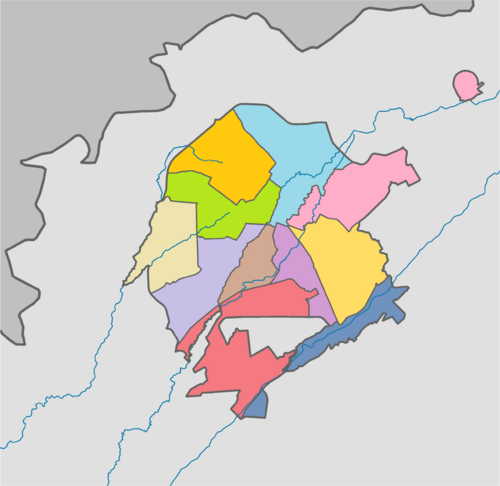
bod
Ulugbek
tohur
saray
R e g i o n
Famous Landmarks
Because much of Tashkent was destroyed in the 1917 revolution and the 1966 earthquake, not many very old buildings remain. However, Tashkent has many interesting museums and monuments from the Soviet era.
Here are some of Tashkent's important landmarks:
- Kukeldash Madrasah: This old school dates back to the 1500s. It is being restored and is currently used as a religious school.
- Chorsu Bazaar: This huge open-air market is in the old part of Tashkent. You can find almost anything for sale here, and it's a popular spot for tourists.
- Hazrati Imam Complex: This complex includes mosques, a shrine, and a library. The library holds a very old copy of the Quran from 655 AD, said to be stained with the blood of a murdered leader.
- Qaffol Shoshi mausoleum: This tomb was built in 1542 to honor a famous Islamic scholar.
- Yunus Khan Mausoleum: This is a group of three tombs from the 1400s. The largest one belongs to Yunus Khan, the grandfather of Babur, who founded the Mughal Empire.
- Palace of Prince Romanov: This palace belonged to a Russian prince who was sent to Tashkent in the 1800s. It's now used by the Ministry of Foreign Affairs.
- Alisher Navoi Opera and Ballet Theatre: This beautiful theater was built by Japanese prisoners of war after World War II. It hosts Russian ballet and opera shows.
- Fine Arts Museum of Uzbekistan: This museum has a large collection of art from before the Russian period, including ancient murals and statues. It also has a collection of paintings that once belonged to Prince Romanov.
- Museum of Applied Arts: This museum is in a traditional house that is a work of art itself. It displays traditional applied art from the 1800s and 1900s.
- State Museum of History of Uzbekistan: This is the largest museum in the city, located in what used to be the Lenin Museum.
- Amir Timur Museum: This museum has a bright blue dome and beautiful decorations inside. It shows exhibits about Timur and Uzbekistan's first president, Islam Karimov. Next to it is Amir Timur Square, with a statue of Timur on horseback and lovely gardens.
- Navoi Literary Museum: This museum honors Uzbekistan's famous writer, Alisher Navoi. It has old manuscripts and miniature paintings.
- The Tashkent Metro: Tashkent's subway system is famous for its amazing designs and architecture in its stations. For a long time, taking photos inside was not allowed, but this rule changed in 2018.
Tashkent also has a World War II memorial park and a monument honoring defenders of the homeland.
Education in Tashkent
Many important scientific centers in Uzbekistan, like the Academy of Sciences of Uzbekistan, are in Tashkent. The city also has many universities and colleges, including:
- Amity University in Tashkent
- New Uzbekistan University
- Tashkent State Pedagogical University
- TEAM University
- Tashkent State Technical University
- Westminster International University in Tashkent
- Turin Polytechnic University in Tashkent
- National University of Uzbekistan
- University of World Economy and Diplomacy
- Tashkent State Economic University
- Tashkent University of Information Technologies
- Inha University Tashkent
- AKFA UNIVERSITY
- Webster University in Tashkent
Media and News
Tashkent has several newspapers published in Uzbek, English, and Russian. The city also has many television and cable television services. The Tashkent Tower is the second tallest building in Central Asia and is used for broadcasting. Tashkent also has advanced digital broadcasting systems.
Getting Around and Shopping
- Tashkent Metro: The city has a subway system.
- Islam Karimov Tashkent International Airport: This is the largest airport in Uzbekistan, connecting Tashkent to cities in Asia, Europe, and North America.
- Tashkent–Samarkand high-speed rail line: A fast train connects Tashkent to Samarkand.
- The trolleybus system was closed in 2010.
- Tram service ended on May 1, 2016.
Tashkent has several shopping malls, such as Next, Samarqand Darvoza, and Kontinent. Many of these malls are managed by the Tower Management Group.
The most famous theater in the capital is the Alisher Navoi Theater, which regularly hosts ballet and opera shows. The Ilkhom Theater, started in 1976, was the first independent theater in the Soviet Union. It is still open today and is known for its history.
Sports in Tashkent
Football is the most popular sport in Tashkent. The main football clubs are Pakhtakor Tashkent FK, FC Bunyodkor, and PFC Lokomotiv Tashkent. All three teams play in Uzbekistan's top league. Famous footballers like Maksim Shatskikh were born in Tashkent.
Humo Tashkent is a professional ice hockey team started in 2019. They play their games at the Humo Ice Dome. Both the team and the arena are named after the mythical Huma bird.
Many athletes from Tashkent have become famous, including cyclist Djamolidine Abdoujaparov and tennis players Denis Istomin, Akgul Amanmuradova, and Iroda Tulyaganova. Gymnasts Alina Kabaeva and Alexander Shatilov were also born in the city.
Tashkent hosted the 2021 Weightlifting World Championships. Uzbekistan has won gold medals in weightlifting at the Rio and Tokyo Olympic Games.
Famous People from Tashkent
- Behzod Abduraimov, a classical pianist.
- Nodirbek Abdusattorov, a chess grandmaster.
- Abdulla Aripov, a politician and the current Prime Minister of Uzbekistan.
- Rustam Kasimdzhanov, a chess player and former World Champion.
- Alisher Usmanov, a well-known businessman.
- Milana Vayntrub, an American actress and comedian.
- Zulfiya, a famous writer and poet.
Sister Cities
Tashkent has sister city relationships with many cities around the world:
Images for kids
See also
 In Spanish: Taskent para niños
In Spanish: Taskent para niños


